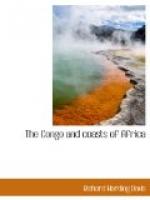We were four white men: Captain Jensen, his engineer, and the other passenger, Captain Anfossi, a young Italian. Before he reached his post he had to travel one month on the Deliverance and for another month walk through the jungle. He was the most cheerful and amusing companion, and had he been returning after three years of exile to his home he could not have been more brimful of spirits. Captain Jensen was a Dane (almost every river captain is a Swede or a Dane) and talked a little English, a little French, and a little Bangala. The mechanician was a Finn and talked the native Bangala, and Anfossi spoke French. After chop, when we were all assembled on the upper deck, there would be the most extraordinary talks in four languages, or we would appoint one man to act as a clearing-house, and he would translate for the others.
On the lower deck we carried twenty “wood boys,” whose duty was to cut wood for the furnace, and about thirty black passengers. They were chiefly soldiers, who had finished their period of service for the State, with their wives and children. They were crowded on the top of the hatches into a space fifteen by fifteen feet between our cabin door and the furnace. Around the combings of the hatches, and where the scuppers would have been had the Deliverance had scuppers, the river raced over the deck to a depth of four or five inches. When the passengers wanted to wash their few clothes or themselves they carried on their ablutions and laundry work where they happened to be sitting. But for Anfossi and myself to go from our cabin to the iron ladder of the bridge it was necessary to wade both in the water and to make stepping stones of the passengers. I do not mean




